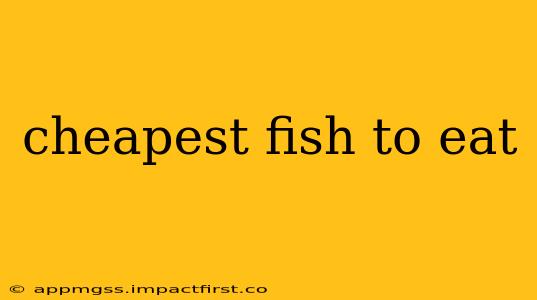Eating fish is a fantastic way to boost your health, providing essential omega-3 fatty acids and lean protein. However, the price of seafood can be daunting for budget-conscious consumers. This guide explores the cheapest fish to eat, helping you enjoy delicious, healthy seafood without breaking the bank. We'll also tackle some frequently asked questions to make your seafood shopping even easier.
What are the cheapest types of fish?
The cheapest fish often depend on your location and the season, but generally, some consistently affordable options include:
-
Canned Tuna: This is arguably the king of budget-friendly seafood. Canned tuna is widely available, incredibly versatile, and packed with protein. Look for options packed in water rather than oil for a healthier choice.
-
Frozen Fish: Freezing fish preserves it well and often makes it more affordable than fresh. Look for options like frozen cod, tilapia, or catfish. These are generally less expensive than their fresh counterparts.
-
Tilapia: Often farmed, tilapia is a widely available and inexpensive fish. It's mild in flavor and easy to cook. However, be mindful of sourcing; sustainably farmed tilapia is preferable.
-
Catfish: Another farmed fish, catfish is readily available and affordable, offering a hearty and slightly sweet taste.
-
Herring: Often sold as sardines or kippers, herring is a nutrient-rich, oily fish that's typically quite affordable. It's packed with flavor and can be prepared in various ways.
Is frozen fish as healthy as fresh fish?
Yes, frozen fish is generally just as nutritious as fresh fish. The freezing process happens quickly, preserving most of the nutrients. In fact, frozen fish can sometimes be even more nutritious than fresh fish that has been sitting on ice for days, potentially losing some nutrients. The key is to ensure the fish is properly frozen and handled correctly.
What is the healthiest cheap fish?
While all the above options are relatively healthy, canned tuna and herring stand out for their high omega-3 content. Omega-3s are essential fatty acids that offer numerous health benefits. However, moderation is key, as some canned tuna varieties may be higher in sodium.
Where can I buy the cheapest fish?
The best place to buy the cheapest fish depends on your location, but here are some suggestions:
- Discount grocery stores: Often offer competitive prices on frozen fish and canned goods.
- Ethnic grocery stores: These stores sometimes carry less common but very affordable fish options.
- Bulk buying: Purchasing larger quantities can often lead to lower per-unit costs.
Are there any health concerns with eating cheap fish?
While generally safe and healthy, it's crucial to consider the sourcing of your fish, especially with farmed varieties. Some farmed fish may have higher levels of certain contaminants. Look for sustainably sourced options when possible, and be mindful of portion sizes.
How can I make cheap fish taste better?
Even the most affordable fish can be transformed into a delicious meal with the right preparation. Experiment with flavorful marinades, herbs, spices, and cooking methods. A little creativity can go a long way!
Conclusion: Savoring Seafood on a Budget
Eating fish doesn't have to be expensive. With a little planning and knowledge, you can enjoy delicious and nutritious seafood without breaking the bank. By exploring the options listed above and considering the tips provided, you can incorporate healthy fish into your diet without compromising your budget. Remember to choose sustainably sourced options whenever possible to ensure both your health and the health of our oceans.
